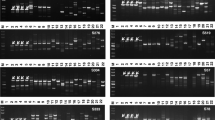Abstract
Phoma foveata and P. exigua variety exigua both infect potatoes and are morphologically very similar. P. foveata produces a pigment which allows differentiation from P. exigua in culture. Discrimination of the two species based on the production of a secondary metabolite, which is dependent on the growth conditions, is not reliable. Therefore, there is a need to develop nucleic acid based identification markers. A 482 bp random amplified polymorphic DNA (RAPD) fragment from P. foveata was isolated and sequenced. Polymerase chain reaction (PCR) primers, developed from the sequence of the RAPD product, amplified a 474 bp fragment for P. foveata and P. exigua varieties exigua, diversispora, inoxydibilis and sambuci-nigrae. The similarity of the PCR fragments was demonstrated by sequence analysis and by using the restriction enzymes DdeI and DpnII. P. foveata was distinguished from the four varieties of P. exigua on the basis of the RFLP patterns of the PCR fragment. Ten isolates of P. foveata and nine of P. exigua var. exigua from different geographic locations were tested and all isolates but one showed the restriction digest pattern of the PCR fragment (PCR-RFLP) specific to each species. One isolate of P. foveata demonstrated a PCR-RFLP pattern similar to P. exigua var. exigua leading to the conclusion that the isolate had been previously misidentified as a strain of P. foveata lacking the ability to produce pigment.
Similar content being viewed by others
References
Boerema GH (1967) The Phoma organisms causing gangrene of potatoes. Neth J Pl Path 73: 190–192
Boerema GH and Höweler LH (1967) Phoma exigua Desm. and its varieties. Persoonia 5: 15–28
Boerema GH (1976) The Phoma species studied in culture by Dr RWG Dennis. Trans Brit Mycol Soc 67: 289–319
Boerema GH, Loerakker WM and Hamers MEC (1987) Checklist for scientific names of common parasitic fungi. Supplement Series 2a (additions and corrections). Fungi on field crops: beet and potato; caraway, flax and oilseed poppy. Neth J Pl Path 93: 1–20
Boyd AEW (1972) Potato storage diseases. Rev Pl Path 51: 297–319
Dhingra OD and Sinclair JB (1985) Culture media and their formulas. In: Basic Plant Pathology Methods (p 302) CRC Press, Boca Raton
EPPO (1997) Phoma exigua var. foveata data sheets on quarantine pests. Prepared by CABI and EPPO for the European Union. Quarantine pests for Europe (pp 865–871) University Press, Cambridge
Faris-Mokaiesh S, Boccara M, Denis J-B, Derrien A and Spire D (1996) Differentiation of the 'Ascochyta complex' fungi of pea by biochemical and molecular markers. Curr Genet 29: 182–190
Garner KJ and Slavicek JM (1996) Identification and characterization of a RAPD-PCR marker for distinguishing Asian and North American gypsy moths. Insect Molec Biol 5: 81–91
Keinath AP, Farnham MW and Zitter TA (1995) Morphological, pathological and genetic differentiation of Didymella bryoniae and Phoma spp. isolated from cucurbits. Phytopathology 85: 364–369
Malcolmson JF (1958) A consideration of the species of Phoma which parasitize potatoes. Trans Brit Mycol Soc 41: 413–418
Möller EM, Bahnweg G, Sandermann H and Geiger HH (1992) A simple and efficient protocol for isolation of high molecular weight DNA from filamentous fungi, fruit bodies, and infected plant tissues. Nucleic Acids Res 20: 6115–6116
Montel E, Bridge PD and Sutton BC (1991) An integrated approach to Phoma systematics. Mycopathologia 115: 89–103
Mosch WHM and Mooi JC (1975) A chemical method to identify tuber rot in potato caused by Phoma exigua var. foveata. Neth J Pl Path 81: 86–88
Mullis KB and Faloona FA (1987) Specific synthesis of DNA in vitro via a polymerase-catalysed chain reaction. Methods Enzymol 155: 335–350
Otazú V, Boerema GH, Mooi JC and Salas B (1979) Possible geographical origin of Phoma exigua var. foveata, the principal causal organism of potato gangrene. Potato Res 22: 333–338
Ouellet T and Seifert KA (1993) Genetic characterization of Fusarium graminearum strains using RAPD and PCR amplification. Phytopathology 83: 1003–1007
Paran I and Michelmore TW (1993) Development of reliable PCR-based markers linked to downy mildew resistance in lettuce. Theor Appl Genet 85: 985–993
Rollo F, Salvi R and Torchia P (1990) Highly sensitive and fast detection of Phoma tracheiphila by polymerase chain reaction. Appl Microbiol Biotechnol 32: 572–576
Saiki RK, Scharf S, Faloona F, Mullis KB, Horn GT, Erlich HA and Arnheim N (1985) Enzymatic amplification of β-globin genomic sequences and restriction site analysis for diagnosis of sickle cell anemia. Science 230: 1350–1354
Sutton BC (1980) The Coelomycetes Fungi Imperfecti with pycnidia acervuli and stromata. Commonwealth Mycological Institute Kew, Surrey, England
Welsh J and McClelland M (1990) Fingerprinting genomes using PCR with arbitrary primers. Nucleic Acids Res 18: 7213–7218
White TJ, Bruns T, Lee S and Taylor J (1990) Amplification and direct sequencing of fungal ribosomal RNA genes for phylogenetics. In: Innis MA, Gelfand DH, Sninsky JJ and White TJ (eds) PCR Protocols (pp 315–322) Academic Press, San Diego
Williams JGK, Kubelik AR, Livak KJ, Rafalski JA and Tingey SV (1990) DNA polymorphisms amplified by arbitrary primers are useful as genetic markers. Nucleic Acids Res 18: 6531–6535
Author information
Authors and Affiliations
Rights and permissions
About this article
Cite this article
Macdonald, J.E., White, G.P. & Côté, MJ. Differentiation of Phoma foveata from P. exigua using a RAPD Generated PCR-RFLP Marker. European Journal of Plant Pathology 106, 67–75 (2000). https://doi.org/10.1023/A:1008795805409
Issue Date:
DOI: https://doi.org/10.1023/A:1008795805409




